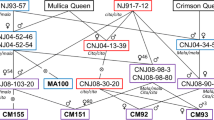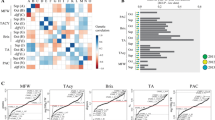Abstract
The fruit of American cranberry (Vaccinium macrocarpon Ait.) is known for its tart, acidic taste. Although some acidity is required for expressing fruit flavor, the high acidity of cranberry requires considerable amounts of “added-sugars” to make cranberry products palatable. Reducing acidity of cranberry would allow for less sugar to be added to cranberry products. In fruit, total acidity is quantified as titratable acidity (TA) in citric acid equivalents and typically ranges from 2.3 to 2.5% in cranberry. This study characterized the genetics of a low acid trait (TA≈1.5%), due to lower citric acid (~ 2 mg/g fresh weight), identified in an undomesticated cranberry germplasm accession. To determine the inheritance of this trait, this accession was used in a series of crosses. The progeny of these crosses exhibited phenotypic segregation consistent with single-gene Mendelian inheritance, with the low citric acid trait being largely recessive. Bulk segregant analysis using simple sequence repeat (SSR) markers identified two SSR markers within < 1 cM that co-segregated with the low citric acid trait. Genotypic variation indicated that the locus, referred to as CITA, was multi-allelic with a semidominant hierarchy of alleles. Further fine mapping, through genotyping-by-sequencing, identified single nucleotide polymorphisms (SNPs) that placed the CITA locus on a distal end of chromosome 1. Competitive allele-specific PCR (KASP) assays generated based on selected SNPs, in combination with the SSR markers identified, will facilitate marker-assisted selection (MAS) for low citric acid phenotypes in cranberry. Utilization of MAS will accelerate the development of reduced acidity cranberry cultivars.





Similar content being viewed by others
References
Aprile A, Federici C, Close TJ et al (2011) Expression of the H+-ATPase AHA10 proton pump is associated with citric acid accumulation in lemon juice sac cells. Funct Integr Genomics 11:551–563. https://doi.org/10.1007/s10142-011-0226-3
Bae H, Yun SK, Jun JH et al (2014) Assessment of organic acid and sugar composition in apricot, plumcot, plum, and peach during fruit development. J Appl Bot Food Qual 87:24–29. https://doi.org/10.5073/JABFQ.2014.087.004
Bates RP, Morris JR, Crandall PG (2001) Principles and practices of small - and medium - scale fruit juice processing. Food and Agriculture Organization 146
Broman KW, Wu H, Sen S, Churchill GA (2003) R/qtl: QTL mapping in experimental crosses. Bioinformatics 19:889–890. https://doi.org/10.1093/bioinformatics/btg112
Butelli E, Licciardello C, Ramadugu C et al (2019) Noemi controls production of flavonoid pigments and fruit acidity and illustrates the domestication routes of modern citrus varieties. Current Biology 29:158–164.e2. https://doi.org/10.1016/j.cub.2018.11.040
Cantarel BL, Korf I, Robb SMC et al (2008) MAKER: An easy-to-use annotation pipeline designed for emerging model organism genomes. Genome Res 18:188–196. https://doi.org/10.1101/gr.6743907
Catchen JM, Amores A, Hohenlohe P et al (2011) Stacks: building and genotyping loci de novo from short-read sequences. G3: Genes. Genomes, Genetics 1:171–182. https://doi.org/10.1534/g3.111.000240
Cercós M, Soler G, Iglesias DJ et al (2006) Global analysis of gene expression during development and ripening of citrus fruit flesh. A proposed mechanism for citric acid utilization. Plant Mol Biol 62:513–527. https://doi.org/10.1007/s11103-006-9037-7
Cohen S, Tzuri G, Harel-Beja R et al (2012) Co-mapping studies of QTLs for fruit acidity and candidate genes of organic acid metabolism and proton transport in sweet melon (Cucumis melo L.). Theor Appl Genet 125:343–353. https://doi.org/10.1007/s00122-012-1837-3
Cohen S, Itkin M, Yeselson Y et al (2014) The PH gene determines fruit acidity and contributes to the evolution of sweet melons. Nat Commun 5:1–9. https://doi.org/10.1038/ncomms5026
Covarrubias-Pazaran G, Diaz-Garcia L, Schlautman B, Deutsch J, Salazar W, Hernandez-Ochoa M, Grygleski E, Steffan S, Iorizzo M, Polashock J, Vorsa N (2016) Exploiting genotyping by sequencing to characterize the genomic structure of the American cranberry through high-density linkage mapping. BMC Genomics 17:451. https://doi.org/10.1186/s12864-016-2802-3
Daverdin G, Johnson-Cicalese J, Zalapa J et al (2017) Identification and mapping of fruit rot resistance QTL in American cranberry using GBS. Mol Breeding 37:38. https://doi.org/10.1007/s11032-017-0639-3
Diaz-Garcia L, Schlautman B, Covarrubias-Pazaran G et al (2018) Massive phenotyping of multiple cranberry populations reveals novel QTLs for fruit anthocyanin content and other important chemical traits. Mol Genet Genomics 293:1379–1392. https://doi.org/10.1007/s00438-018-1464-z
Ehlenfeldt MK, Meredith FI, Ballington JR (1994) Unique organic acid profile of rabbiteye vs. highbush blueberries. HortScience 29:321–323. https://doi.org/10.21273/HORTSCI.29.4.321
Fang DQ, Federici CT, Roose ML (1997) Development of molecular markers linked to a gene controlling fruit acidity in citrus. Genome 40:841–849. https://doi.org/10.1139/g97-809
Fong SK (2019) The genetic basis of organic acid variation in cranberry fruit. PhD Dissertation, Rutgers University.
Georgi L, Johnson-Cicalese J, Honig J et al (2013) The first genetic map of the American cranberry: exploration of synteny conservation and quantitative trait loci. Theor Appl Genet 126:673–692. https://doi.org/10.1007/s00122-012-2010-8
Li H (2011) A statistical framework for SNP calling, mutation discovery, association mapping and population genetical parameter estimation from sequencing data. Bioinformatics 27:2987–2993. https://doi.org/10.1093/bioinformatics/btr509
Li H, Durbin R (2009) Fast and accurate short read alignment with Burrows–Wheeler transform. Bioinformatics 25:1754–1760. https://doi.org/10.1093/bioinformatics/btp324
Li S, Yin X, Xie X et al (2016) The Citrus transcription factor, CitERF13, regulates citric acid accumulation via a protein-protein interaction with the vacuolar proton pump, CitVHA-c4. Sci Rep 6:20151. https://doi.org/10.1038/srep20151
Lobit P, Genard M, Soing P, Habib R (2006) Modelling malic acid accumulation in fruits: relationships with organic acids, potassium, and temperature. J Exp Bot 57:1471–1483. https://doi.org/10.1093/jxb/erj128
McCamey DA, Thrope TM, McCarthy JP (1990) Coffee bitterness. In: Rouseff RL (ed) Bitterness in Foods and Beverages. Elsevier Science Publishers B.V. Amsterdam, The Netherlands, pp 169–182
Michelmore RW, Paran I, Kesseli RV (1991) Identification of markers linked to disease-resistance genes by bulked segregant analysis: a rapid method to detect markers in specific genomic regions by using segregating populations. Proc Natl Acad Sci 88:9828–9832. https://doi.org/10.1073/pnas.88.21.9828
Nishiyama I, Fukuda T, Shimohashi A, Oota T (2008) Sugar and organic acid composition in the fruit juice of different Actinidia varieties. Food Sci Technol Res 14:67–73. https://doi.org/10.3136/fstr.14.67
Rosas JE, Bonnecarrère V, Pérez de Vida F (2014) One-step, codominant detection of imidazolinone resistance mutations in weedy rice (Oryza sativa L.). Electron J Biotechnol 17:95–101. https://doi.org/10.1016/j.ejbt.2014.02.003
Rubico SM, McDaniel MR (1992) Sensory evaluation of acids by free-choice profiling. Chemical Senses 17:273–289. https://doi.org/10.1093/chemse/17.3.273
Schlautman B, Covarrubias-Pazaran G, Diaz-Garcia LA et al (2015) Development of a high-density cranberry SSR linkage map for comparative genetic analysis and trait detection. Mol Breeding 35:177. https://doi.org/10.1007/s11032-015-0367-5
Schlautman B, Covarrubias-Pazaran G, Diaz-Garcia L, Iorizzo M, Polashock J, Grygleski E, Vorsa N and Zalapa J (2017) Construction of a high-density American cranberry (Vaccinium macrocarpon Ait.) composite map using genotyping-by-sequencing for multi-pedigree linkage mapping. G3 7:1177–1189
Sortwell D, NutriQuim SDC, Woo A (1996). Improving the flavor of fruit products with acidulants. Expotecnoalimentaria ‘96 28
Strazzer P, Spelt CE, Li S et al (2019) Hyperacidification of citrus fruits by a vacuolar proton-pumping P-ATPase complex. Nat Commun 10:1–11. https://doi.org/10.1038/s41467-019-08516-3
United States Department of Agriculture- National Agriculture Statistics Service (2017) Wisconsin Ag News- Cranberries [Data file] Retrieved from https://www.nass.usda.gov/Statistics_by_State/Wisconsin/Publications/Crops/2018/WI-Cranberries-Annual-06-18.pdf. Accessed 16 Apr 2020
Vorsa N (2010) Cranberry variety named ‘NJS98-35’. Cranberry. In: Register of New Fruit and Nut Cultivars List 45. Eds: J. R. Clark and C. E Finn HortSci 45:716–756
Vorsa N, Johnson-Cicalese J (2012) American cranberry. In: Badenes ML, Byrne DH (eds) Fruit Breeding. Springer US, Boston, MA, pp 191–223
Walker RP, Famiani F (2018) Organic acids in fruits. In: Horticultural Reviews. John Wiley & Sons, Ltd, pp 371–430
Wang Y, Johnson-Cicalese J, Singh AP, Vorsa N (2017) Characterization and quantification of flavonoids and organic acids over fruit development in American cranberry (Vaccinium macrocarpon) cultivars using HPLC and APCI-MS/MS. Plant Sci 262:91–102. https://doi.org/10.1016/j.plantsci.2017.06.004
Wang Y, Fong SK, Singh AP, et al. (2019) Variation of anthocyanins, proanthocyanidins, flavonols, and organic acids in cultivated and wild diploid blueberry species. HortScience 54:576–585. https://doi.org/10.21273/HORTSCI13491-18
Wu BH, Zhao JB, Chen J et al (2012) Maternal inheritance of sugars and acids in peach (P. persica (L.) Batsch) fruit. Euphytica 188:333–345. https://doi.org/10.1007/s10681-012-0668-2
Yu Y, Chen C, Gmitter FG (2016) QTL mapping of mandarin (Citrus reticulata) fruit characters using high-throughput SNP markers. Tree Genet Genomes 12:77. https://doi.org/10.1007/s11295-016-1034-7
Funding
This study was funded by the following: the New Jersey Agricultural Experiment Station project 12148, USDA-NIFA-AFRI Grant No. 2017-67013-26215, New Jersey Blueberry and Cranberry Research Council, and Cranberry Institute.
Author information
Authors and Affiliations
Corresponding author
Ethics declarations
Conflict of interest
The authors declare that they have no conflict of interest.
Additional information
Communicated by C. Chen
Publisher’s note
Springer Nature remains neutral with regard to jurisdictional claims in published maps and institutional affiliations.
Electronic supplementary material
ESM 1
(DOCX 67 kb)
Rights and permissions
About this article
Cite this article
Fong, S.K., Kawash, J., Wang, Y. et al. A low citric acid trait in cranberry: genetics and molecular mapping of a locus impacting fruit acidity. Tree Genetics & Genomes 16, 42 (2020). https://doi.org/10.1007/s11295-020-01432-4
Received:
Revised:
Accepted:
Published:
DOI: https://doi.org/10.1007/s11295-020-01432-4




